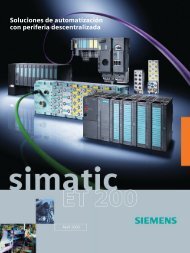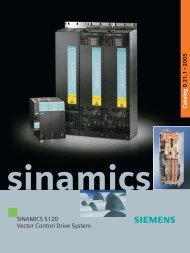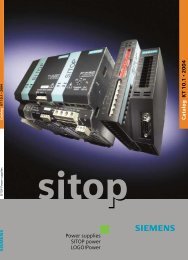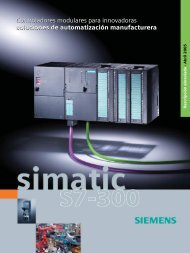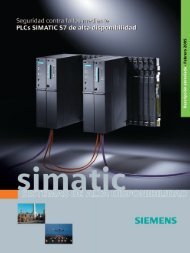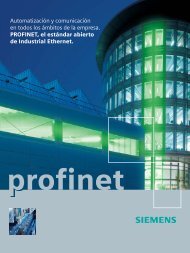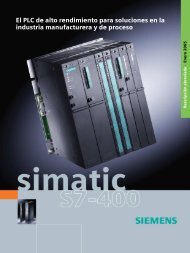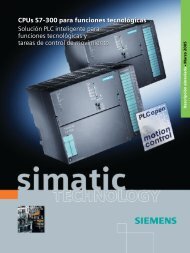SIMATIC PCS 7 process control system
SIMATIC PCS 7 process control system
SIMATIC PCS 7 process control system
You also want an ePaper? Increase the reach of your titles
YUMPU automatically turns print PDFs into web optimized ePapers that Google loves.
Fault-tolerant automation <strong>system</strong><br />
Fault-tolerant automation <strong>system</strong>s<br />
Fault-tolerant automation <strong>system</strong>s are used to minimize the<br />
risk of production failures. The higher investment in fault-tolerant<br />
automation <strong>system</strong>s is often negligible compared to the<br />
costs resulting from production stoppages. The higher the<br />
costs resulting from loss of production, the more important a<br />
fault-tolerant <strong>system</strong> becomes.<br />
The AS 414H and AS 417H models are the fault-tolerant automation<br />
<strong>system</strong>s for use with <strong>SIMATIC</strong> <strong>PCS</strong> 7. They are based on<br />
the 1-out-of-2 principle and switch to the backup <strong>system</strong> in<br />
the event of a fault. These <strong>system</strong>s use a completely redundant<br />
design to maximize availability. This means that all major<br />
components such as CPU, power supply and hardware for<br />
coupling the two CPUs are present in pairs. Which other components<br />
are also made available in pairs in the interest of<br />
availability depends on the particular automation task.<br />
The two sub<strong>system</strong>s of a redundant automation <strong>system</strong> are<br />
electrically isolated from one another. This increases the <strong>system</strong><br />
stability with respect to EMC interferences. A redundant<br />
automation <strong>system</strong> can be installed mechanically in a onerack<br />
or two-rack architecture. Automation <strong>system</strong>s are installed<br />
in two racks, for example, if the two parts of the automation<br />
<strong>system</strong> have to be physically separated from one another<br />
by a fire-resistant wall. Appropriate complete units are<br />
available for every type of application. Mixed operation of redundant<br />
and standard <strong>system</strong>s is also possible.<br />
Failsafe automation <strong>system</strong>s<br />
Failsafe automation <strong>system</strong>s (F/FH <strong>system</strong>s) are used for critical<br />
applications in which an incident can result in danger to<br />
persons, plant damage or environmental pollution. They detect<br />
not only faults in the <strong>process</strong> but also their own internal<br />
errors, and will automatically set the plant to a safe state if a<br />
fault is detected.<br />
The failsafe automation <strong>system</strong>s are based on the hardware of<br />
the fault-tolerant AS 414H and AS 417H <strong>system</strong>s. They are<br />
available in two versions:<br />
■ As single-channel AS 414F/AS 417F (with only one CPU)<br />
■ As fault-tolerant AS 414FH/AS 417FH (with redundant<br />
CPU)<br />
The failsafe automation <strong>system</strong>s are TÜV-certified, and comply<br />
with the safety requirements up to SIL 3 according to<br />
IEC 61508. They <strong>process</strong> standard and safety functions in one<br />
single <strong>system</strong>. The safety functions are <strong>process</strong>ed twice in different<br />
<strong>process</strong>or sections of one CPU. Potential errors are detected<br />
by the <strong>system</strong> during the subsequent comparison of<br />
results.<br />
The redundancy of the FH <strong>system</strong>s only serves to increase the<br />
availability. It is not relevant to <strong>process</strong>ing of the safety functions<br />
or the associated fault detection.<br />
Technical specifications<br />
Automation <strong>system</strong><br />
AS 414-3<br />
AS 414H<br />
Memory card [in MB] 2 2 4 8 4 4 16 16<br />
Analog value measurements<br />
30 50 150 500<br />
Digital value measurements<br />
60 150 400 1000<br />
PID <strong>control</strong>s 20 50 130 200<br />
Motors 20 75 150 300<br />
Valves 25 75 150 300<br />
SFC 2 20 50 100<br />
Steps 4 200 500 1000<br />
Dosing 2 5 15 30<br />
Digital inputs DI 100 300 850 1500<br />
Digital outputs DO 50 150 315 630<br />
Analog inputs AI 30 100 275 500<br />
Analog outputs AO 20 50 130 200<br />
Typical mixed quantity frameworks for <strong>SIMATIC</strong> <strong>PCS</strong> 7 automation<br />
<strong>system</strong>s<br />
AS 416-2<br />
AS 416-3<br />
AS 417-4<br />
AS 417H<br />
AS 417-4<br />
AS 417H<br />
Automation <strong>system</strong> 27




